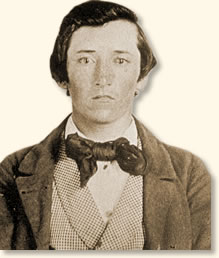 |
| William Quantrill |
150 years ago today, William Clarke Quantrill and between 300 and 400 Southern sympathizers rode into Lawrence, Kansas with the intention of burning it down and killing any man who sided with the abolitionists. Between the hours of 5 A.M. and 9 A.M., Quantrill and his men killed between 150 and 200 men and boys and burned most of the houses and businesses down. The men then retreated south, burned down the small Santa Fe Trail town of Brooklyn and then were chased by Union soldiers to Paola where they were able to elude capture and escape back to Missouri.
The years between 1854 when Kansas Territory opened for settlement and the Civil War was a constant stream of retaliation and back and forth between anti- and pro-slavery factions. Quantrill's Raid, or the Lawrence Massacre, was in retaliation for the Union burning of Osceola, Missouri on September 23, 1861 but was probably exacerbated by the collapse of the woman's prison in Kansas City, Missouri on August 13, 1863. The women were jailed due to General Thomas Ewing's General Order No. 10 which ordered the arrest of anyone get aid or otherwise helping Confederate guerillas. All ten girls in the prison during the collapse were under the age of 20 and four died including the 15-year-old sister of William "Blood Bill" Anderson, Josephine. Rumors at the time pointed to abolitionist sabotage of the prison but the reality was, it was just a poorly constructed building.
 |
| During the Massacre. From Harper's Weekly. |
After the Massacre, General Ewing authorized General Order No. 11 which ordered the depopulation of three and a half Missouri counties along the Kansas border (Bates, Cass, Jackson and part of Vernon). All people had to leave their property unless they lived within one mile of the major towns of Independence, Hickman Mills, Pleasant Hill and Harrisonville. Part of Kansas City was also spared. The Order was supposed to be a deterent to additional pro-Southern activity but also pro-Union activity because Senator James Lane's proposal was to attack and burn all the counties along the Kansas-Missouri border. Unfortunately, Gen. Ewing was unable to control sent to carry out the order and animals and other property were stolen and houses, farms and outbuildings were burned.
 |
A George Caleb Bingham painting of Gen. Ewing watching from his horse as Order
No. 11 is carried out. Bingham called the order an "act of imbecility." |
Lawrence was rebuilt fairly quickly with some businesses able to reopen within the next month. Quantrill, meanwhile, rode his gang to Texas where within a month, they had splintered and never acheived the success they had in Lawrence. Quantrill died of wounds he received in Kentucky in 1865 and is buried in The Fourth Street Cemetery in Dover, Ohio after being originally interred in St. John's Cemetery in Louisville, Kentucky. Only one of Quantrill's men was captured in Lawrence during the raid. Larkin Skaggs, believing Quantrill left the way he came, was cornered leaving town and was killed. It was rumored that Skaggs' body was hung up in Lawrence and Skagg's Find A Grave says he is buried in St. Peter Pioneer Cemetery but more than likely he was thrown in the river or even just buried somewhere in an unmarked grave.
 |
| The ruins of Lawrence after the raid. |
All around Lawrence are reminders of the Massacre. The city seals even commemorates the attack with a phoenix rising from the ruins of the Eldridge Hotel above the date 1863.
Front:
DEDICATED TO THE MEMORY OF
THE ONE HUNDRED AND FIFTY CITIZENS
WHO DEFENCELESS FELL
VICTIMS TO THE INHUMAN FEROCITY OF BORDER
GUERRILLAS LED BY THE INFAMOUS QUANTRELL
IN HIS RAID UPON LAWRENCE.
AUGUST 21ST, 1863.
------
ERECTED MAY 20TH, 1886.
Reverse:
THE ROLLS OF THEIR NAMES MAY BE FOUND IN THE
CITY CLERK'S OFFICE, LAWRENCE, AND IN THE
RECORDS OF THE STATE HISTORICAL
SOCIETY, TOPEKA.
Oak Hill Cemetery, Lawrence, Douglas County, Kansas




